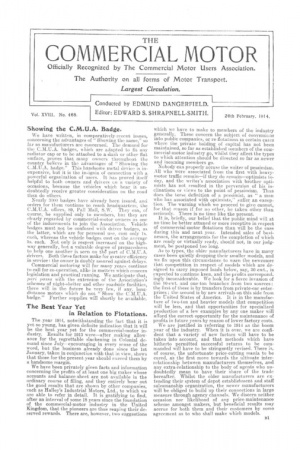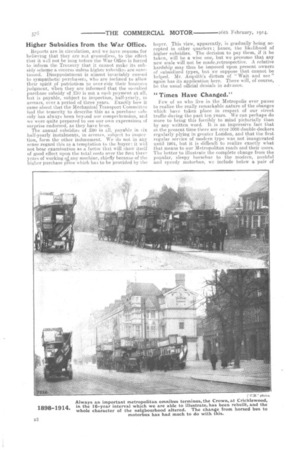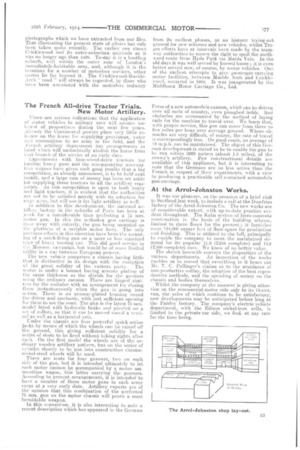COMMERCIAL MOTOR
Page 1

Page 2

Page 3

If you've noticed an error in this article please click here to report it so we can fix it.
Officially Recognized by The Commercial Motor Users Association.
The Authority on all forms of Motor Transport. Largest Circulation.
Conducted by EDMUND DANGERFIELD. Editor: EDWARD S. SHRAPNELL-SMITH.
Showing the C.M.U.A. Badge.
We have written, in comparatively-recent issues, concerning the. advantages of " Showing the name," so far as manufacturers are concerned. The demand for the C.M.U.A. badges, which are adapted to fit any radiator cap or to be attached to a dash or other flat surface, proves that many owners throughout the country behieve in the advantages of " Showing the C.M.U.A. badge." This handsome metal device is inexpensive, but it is the insignia of connection with a powerful organization of users. It has proved itself helpful to both owners and drivers eri a variety of occasions, because the vehicles which bear it. undoubtedly receive greater consideration on the road than do others.
Nearly 3000 badges have already been issued, and orders for them continue to reach headquarters, the C.M.U.A. offices, 89, Pall Mall, S.W. They can, of course,. be supplied only to members, but they are clearly regarded by commercial-motor owners as one of the inducements to join the Association. 'Vehicle badges must not be confused with driver badges, as the latter, which are for personal use, cost only is. each, whereas the vehicle badges cost on the average Ls. each. Not only is respect increased on the highway generally, but a valuable degree of preparedness to help one another is seen on the part of C.M.U.A. drivers. Both these factors make for greater efficiency in service: the owner is doubly assured against delays. Commercial motoring will for many years continue to call for co-operation, alike in matters which concern legislation and practical running. We anticipate that, pars passu with the extension of the Association's schemeaOf night-shelter and other roadside facilities, there will in the future be very few, if any. longdistance motors which do not " Show the C.M.U.A. badge." Further supplies will shortly be available.
The Best Year Yet in Relation to Flotations.
The :year 1914, notwithstanding the fact that it is yet so young, has given definite indication that it will be the best year yet for the commercial-motor industry. Results for 1913 were—after making allowance for the regrettable slackening in Colonial demand since July—encouraging in every sense of the word, but the business already done since the 1st January, taken in conjunction with that in view, shows that those for the present year should exceed them by a handsome margin.
We have been privately given facts and information concerning the profits of at least one big maker whose accounts and balance-sheet are not available in the ordinary course of filing, and they entirely bear out the good results that are shown by other companies, such as Halley's Industrial Motors, Ltd., to which we are able to refer in detail. It is gratifying to find, after an interval of some 18 years since the foundation of the commercial-motor industry in the United Kingdom, that the pioneers are thus reaping their deserved rewards. There are, however, two suggestions which we have to make to members of the industry generally: These concern the subject. of conversions into public companies, or re-flotations in certain cases where the private holding of capital has not been maintained, so far as established members of the commercial-motor industry go, whilst they affect the types to which attention should be directed so far as newer and incoming members go. Nobody can properly accuse the writer of pessimism. All who were associated from the first with heavymotor traffic remain—if they do remain—optimists today, and the writer's association with brother optimists. has not . resulted in the perversion of his inclinations or views to the point of pessimism. Thus does the terse definition of a pessimist, as " a man who has associated with optimists," suffer an exception. The warning which we proceed to give cannot, for that reason if for no other, be taken other than seriously. There is no time like the present. It is, briefly, our belief that the public mind will at no time be better attuned or more receptive in respect of commercial-motor flotations than will be the case during this and next year Intended sales of businesses, the arrangements for the completion of which are ready or virtually ready, should not, in our judgment, be postponed too long.
As to types, the older manufacturers have in many cases been quietly dropping their smaller models, and we fix upon this circumstance to warn the newcomer that competition in respect of models which are designed to carry imposed loads below, say, 30 cwt., is expected to continue keen, and the profits correspondingly inconsiderable. We look for a fierce invasion of the 1O-cwt. and one-ton branches from two sources : the first of these is by transfers from private-ear enter. prises ; the second is by new arrivals on this side from the United States of America. It is in the manufacture of two-ton and heavier models that competition will be less, and that opportunities for specialized production of a few examples by any one maker will afford the correct opportunity for the maintenance of profits in future years by reason of lower factory costs. We are justified in referring to 1914 as the boom year of the industry. When it is over, we are confident that a variety of new factors will have to be taken into account, and that methods which have hitherto permitted successful returns to be commanded will have to be stringently revised. T.here is, of course, the unfortunate price-cutting mania to be cured, as the first move towards the ultimate interrelationship between manufacturers themselves, and any extra-relationship to the body of agents who undoubtedly mean to have their share of the trade hereafter. Whilst the older manufacturers are extending their system of depot establishment and staff salesmanship organization, the newer manufacturers will be obliged to build up their connections in large measure through agency channels, We discern neither occasion nor likelihood of any price-maintenance scheme amongst makers, but beneficial results may accrue for both them and their customers by some agreement as to who shall make which models.
Higher Subsidies from the War Office.
Reports are in circulation, and we have reasons for believing that they are not groundless, to the effect that it will not be long before the War Office is forced to inform the Treasury that it cannot make its subsidy scheme a success unless higher subsidies are sanctioned. Disappointment is almost invariably caused to sympathetic purchasers, who are inclined to allow their spirit of patriotism to over-ride their business judgment, when they are informed that the so-calied purchase subsidy of A;50 is not a cash payment at all, but is payable, subject to inspection, half-yearly, in arrears, over a period of three years. Exactly how it came about that the Mechanical Transport Committee had the temerity to describe this as a purchase subsidy has always been beyond our comprehension, and we were quite prepared to see our own expressions of surprise endorsed, as they have been. The annual subsidies of ;00 in all, payable in six half-yearly instalments, m in arrears, subject to inspec tion., for the other inducement. We do not in any sense regard this as a temptation to the buyer ; it whl not bear examination as a factor that will show itself of good effect upon the. total costs over the first three years of working ot any machine, chiefly because of the higher purchase Piice which has to be provided by the buyer. This view, apparently, is gradually being accepted in other quarters ; hence, the likelihood of higher subsidies. The decision to pay them, if it be taken, will be a wise one, but we presume that any new scale will not be madejetrospective. A relative hardship may thus be imposed upon present owner.; of subsidized types, but we suppose that cannot be helped. Mr. Asquith's dictum of 'Wait and see " again has its application here. There will, of course, be the usual official denials in advance.
"Times Have Changed."
Few of us who live in. the Metropolis ever pause to realize the really remarkable nature of the changes which have taken place in respect of our street traffic during the past ten years. We can perhaps do more to bring this forcibly to mind pictorially than by any written word. It is an impressive fact that at the present time there areover 3000 double-deckers regularly plying in greater London, and that the first regular service of .modern type was not inaugurated until 1904, but it is difficult to realize exactly what that means to our Metropolitan roads and their users. The better to illustrate the complete change from the popular, sleepy horsehus to the modern, pushful and speedy motorbus, we include below a pair of
photographs which we have extracted from our files. That illustrating-the present state of affairs has only been taken quite recently. The earlier one shows Cricklewood and its outer-suburban quietude as it Was no longer ego than 1e98. To-day it is a bustling
ihurb, well within the outer zone of London's immediately-habitable area, and, although it is the terminus for a number of motorbus services, other {mites lie far beyond it. The Cricklewood-Marble reh " road " will always be regarded, by those who e been asseciated with the motorbus industry from its earliest phases, as an historic trying-out ground for new schemes and new vehicles, whilst Trojan efforts have at intervals been made by the tramway authorities to secure the right to spoil the northward route from Hyde Park via Maida Vale. In the old days it was well served by horsed buses ; it is even better served now, of course, by motor vehicles. One of the earliest attempts to give passenger-carrying motor facilities, between Marble Arch and Crieklewood, occurred in 19Oa It was inaugurated by the Middlesex Motor Carriage Co., Ltd.


























